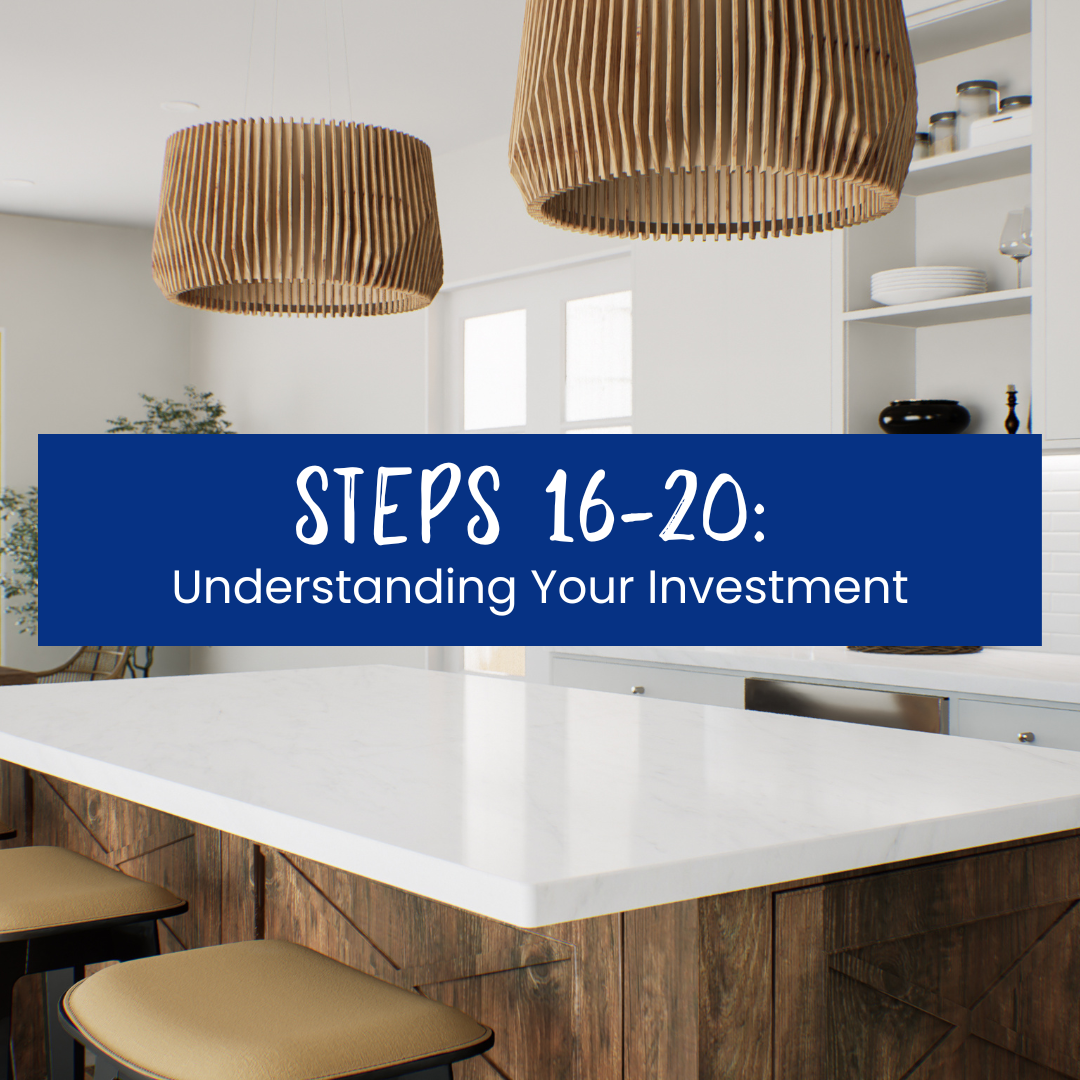Buying Steps 16-20: Understanding Your Investment

Step 16
What This Form Is For
This form helps the seller share important information about the condition of the house you’re buying. It lists things the seller knows about the property, such as any problems or defects. It’s based on the seller's knowledge at the time they fill it out.
What You Need to Know
- Seller’s Disclosure: The seller must tell you about any known issues with the property. They aren’t making guarantees, but they are sharing what they know to the best of their ability.
- Your Rights: Once the seller gives you this form, you have
3 business days to cancel the purchase agreement if you want to. You must let them know in writing if you decide to back out during this time.
- No Form Provided: If the seller doesn’t give you this form, you might lose the chance to back out later based on property condition.
- Not a Guarantee: This form isn’t a promise that the house is free of problems. It’s just what the seller knows.
What You Should Do
- Inspect the House: It’s important to hire a professional to check the home thoroughly. This will give you a better understanding of the condition of the property.
- Ask Questions: If something on the form is unclear or if you have concerns, ask your inspector or get an additional expert for advice.
This document is a tool to help you make an informed decision about buying the house. It’s not part of your official agreement with the seller but is for your information.
Step 17
When touring a home, it is important to take note of items that may need costly repairs. Cosmetic changes or quick fixes are easy to spot, but in the excitement of viewing potential homes, costly repairs sometimes get overlooked. Therefore, we like to educate our clients on potential red flags you should be keeping an eye out for during showings!
Lead paint - Homes made before 1978 are prone to have high levels of lead-based paint, which often has a particular cracking pattern that looks like alligator skin. The dust created from lead-based paint when doors and windows open/close or paint cracks can be very dangerous, especially for kids. If you’re concerned about lead-based paint, you can buy easy-to-use testing kits from Amazon and take them with you to the inspection to quickly and discreetly test the home for lead-based paint. Typical places to look for lead-based paint are on interiors and exteriors of windows and doors, stair stringers, painted interior or exterior railings, porches, garages, and siding, although lead-based paint can be found anywhere throughout an older home.
The Roof - Do you see cracked, bubbling, missing, or broken shingles? That could mean the property needs a new roof right away which can be very expensive.
Windows - New windows aren’t cheap, often costing $500 – $1,000 per window depending on the size and style. Make sure the windows open and shut and that there aren’t any drafts. See if the glass has condensation between the panes which can be a sign of a seal failure. Check to see if the window is single-paned, meaning it’s an older window or double-paned, likely meaning it’s a newer window.
Chimney Cap - if the chimney cap is missing it could indicate the chimney has not been protected from the elements, allowing water in and causing drywall damage, rust, loss of mortar, and other deterioration. In other words, repairs could be costly if the chimney cap is missing.
Heating and cooling systems - check the age and service dates of major systems. Turn on the heat to see if it kicks on and works!
Electrical - Check light switches, see where they lead, if they turn on and off, and listen for buzzing or strange noises. Also check to see if the outlets are 2-prong outlets, indicating older electrical wires in the home, or more modern 3-prong outlets. Also look in the basement to see if you see pipe and conduit, indicating more modern electrical or old knob. Also, look to see if the electrical panel looks old or new.
Plumbing - Simply flush the toilets and listen. Weird creeks, gurgling, or low pressure could mean a nasty problem is on the horizon. Look to see if any exposed plumbing in the basement is made out of newer PVC and copper or if it’s still the old cast iron pipes. Look for any corrosion or rust on the pipes.
Grading - Is the ground wet with puddling near the house after heavy rains? If so, it could mean the exterior is graded towards the house instead of away from the house which could lead to water intrusion issues. Look to see if walkways next to the house slope away or toward the house (hint: you want them to slope away from the house).
*Disclaimer: We are not professional Inspectors. The above are simply suggestions to look for in homes and don’t necessarily mean there is a problem with the home, which is why you should always have a professional and licensed Inspector inspect any properties you are considering buying.
Questions? Contact us at andi@andidyer(dot)com or 360-734-6479.
Step 18
You’ve found properties on the NWMLS you’re interested in seeing, we’ve set up your showings and we head out soon to see them! Before we head out, here are a few important things to know:
Before We Head Out to See Homes, Keep These Tips in Mind!
🔑 Pre-Approval Required: Most Sellers won’t allow showings unless you’re pre-approved, so be prepared!
🥤 Bring Snacks: Touring multiple homes can be exhausting—stay fueled with drinks and snacks!
💡 Vacant Homes: Utilities may not be turned on, so don’t expect lights, heat, or AC in empty houses.
🚻 Plan Ahead: Don’t count on restrooms being available—plan accordingly.
🎠 Kids and Toys: Remind kids not to play with the toys or other items they see in the house.
👟 Slip-On Shoes: Wear comfortable shoes you can easily slip on and off; some Sellers may request shoes be removed.
🕒 Scheduling Rules: Sellers often require 24 hours' notice and may limit showings to certain times or days (e.g., no showings after 6 pm or on Sundays).
☀️ Check the Light: Love sunlight? Try to schedule showings during daylight hours to assess natural light.
🚫 Don’t Touch: Avoid handling furniture or personal items—we don’t want to risk anything breaking!
📹 Smile, You’re on Camera: Assume there are security or nanny cams. Avoid discussing budgets, offers, or personal opinions while inside the home.
❄️ Weather-Ready: Dress appropriately for the weather; driveways and walkways might be snowy, muddy, or icy.
🏡 Focus on the Property: Remember, you’re buying the house, not the furniture or décor.
🤐 Sellers at Home?: If the Sellers are present, be cautious about what you share about yourself or why you’re buying—it could affect negotiations later!
Generally, the day before we are scheduled to look at homes, we will email you an address of where and when we are meeting.
Now let’s see some homes!
Questions? Contact us at andi@andidyer(dot)com or 360-734-6479.
Step 19
Real estate negotiation tips so you can buy your dream home — and not overpay.
You've looked at enough houses to fill an entire season of House Hunters and finally picked one to buy. Now you're ready to make an offer.
Your agent can help guide you through this nail-biting phase of negotiating a house price, but ultimately, you call the shots. Here's how to negotiate like a boss.
Fail #1: Thinking House Price is All That Matters
That house with a price point $15k below your budget? It may seem like a deal — until you add on the costs of maintenance and replacing the aging appliances.
Planning on repainting, remodeling, or landscaping, too? Suddenly the price looks a whole lot higher.
When developing your offer, calculate in the costs that will go above and beyond a mortgage payment. Then you can negotiate with an eye on the total cost of owning the house, not just the sticker price.
On the flip side, the price may not be all that matters to the Seller, either.
She may have to start a job on the other side of the country in a month and value a quick closing. Or she may be looking to rent from you for a bit after the sale until her next home is ready. Sometimes being accommodating is negotiation gold.
Fail #2: Refusing to Back Down on Small Repairs
Before you draw a line in the negotiation sand over, say, a deck with some rotten boards, ask yourself if it's worth losing the house over a repair that would cost less than three thousand dollars.
Say the house price is $800,000 which makes that deck repair less than half of one percent of the cost of the house. There's a lot of emotional energy at this point in the process, so give yourself a break rather than dickering over it.
A house negotiation is not about winning for the sake of winning. It's about getting the house you want at a fair price on good terms.
Fail #3: Waiving Formalities Because You're So in Love With the House
Don't be so blinded by house love that you do something silly like skip some of the formalities of home buying, such as the Home Inspection or the Appraisal, in an effort to close the deal.
Those steps, and others like a pest or septic inspection, are known as contingencies. They're there to protect you from ending up with a six-figure money pit.
Imagine how quickly the house honeymoon would end if you found a mouse infestation or if the identical house across the street sold for much less.
There are other ways to sweeten your offer and get that house:
- Pay some of the Seller's closing costs.
- Offer a fast close.
If this is your first house, speed is an ace up your sleeve because you can move faster than someone who can't buy a new house until they sell the old one (another type of contingency).
And remember, while there's a lot of emotion tied up in choosing a house, it's still a business deal.
Fail #4: Getting Hung Up On a Few Grand
You offered $590,000. The Seller won't budge from $600,000.
Before you walk away, consider this: Ten grand is a lot of money, but in the house-buying world it's not so much. At an interest rate of 5%, with 20% down on a 30-year mortgage, that additional $10,000 will add just $60 a month to your payment.
If you can swing it -- maybe you can cut a small thing out of your budget each month -- it could be worth it.
Fail #5: Folding Because the Inspection Turned Up Issues
A good home inspection is going to turn up something. Usually a lot of somethings. That's good. It means the inspector is doing their job. It’s nearly impossible for an inspection report to come back thinner than a textbook because it includes not only safety issues, but items to repair/replace, repair/maintain, minor defects, ongoing maintenance, things to evaluate, item to monitor during your occupancy, etc.
Plus, many things that turn up on an inspection are easily handled. You can ask the Seller to knock some off the price so you can pay for repairs.
And while some problems may seem scary at first, like a roof leak or plumbing problem, they're almost always fixable and negotiable.
Fail #6: Offering Less Because the Decor is Hideous
The faux-Tiffany swag lamp and trippy orange-and-brown wallpaper make your eyes itch. So you're planning on offering less — way less.
Before you do that, know the market. If it's a Seller's market, your offer may be seen as an insult, especially if the home's in good shape. And just like that, you've lost your dream home.
When you're ready to make that offer, look past the little stuff that you can easily change, and focus your negotiations on what matters, like the location and the bones of the house.
Questions? Contact us at andi@andidyer(dot)com or 360-734-6479.
Step 20
These 10 money and time-saving steps can help you craft a winning bid.
Ah, the offer!
Cinematically speaking, this is the iconic moment — we’d forgive you if you imagined, say, putting a hand on your agent’s shoulder and whispering (in your best Vito Corleone) that you’re going to make them an offer they can’t refuse.
Think Before Making Unreasonable Demands
People like to do business with people they trust. Don’t nitpick over small items like a torn window screen or a $50 valve on a hot water heater. That will just anger the Seller.
In reality, it’s not that simple (or dramatic). Your offer marks the beginning of a back-and-forth between you and the Seller, typically with real estate agents advising you both.
The more intentional you are about your offer, the better your chances of making a successful bid. Follow these 10 steps, and you’ll be well prepared — that’s a true story. ("The Godfather" again. We couldn’t resist.)
#1 Know Your Limits
I am here to help you craft a winning offer. You can trust my advice on price, contingencies, and other terms of the deal: It’s a mutually beneficial relationship. The more collaborative we are the more quickly you’ll be able to move.
But ultimately, it’s you who decides what the offer will be — and you who know what your financial and lifestyle limits are. Buying a home means mixing strong emotions with business savvy, so now is also a good time to reflect on your “musts.”
#2 Setting & Raising Your Price (Within Reason)
Homes always have a listing price. Think of it as the Seller’s opening bid in your negotiation to buy a home.
As the Buyer, your offer will include an offer price. This is the first thing home Sellers look at when they receive an offer.
I’ll help you determine whether the Seller’s listing price is fair by running comps (or comparables), a process that involves comparing the house you’re bidding on to similar properties that recently sold in the neighborhood.
Before you make an offer, talk with me about how high you’re willing to go if the Seller doesn't accept your offer.
While you obviously don’t want to overpay for a house, you may have to up the ante — especially if you initially made a lowball offer. Lean on my available experience to determine how much money you should add to the sales price to make it more enticing to the Seller.
Through our powers of persuasion and using sound logic, I’ll make the counteroffer look even more attractive by pointing out similarly priced “comps” — recently sold homes in your area that are comparable in terms of square footage and features.
As I negotiate, it can feel like things are escalating quickly. It’s stressful. You may feel a sudden urge to do whatever it takes to win.
Before you go overboard, there are two things you must keep in mind:
- You can’t exceed the monetary confines of the pre-approved mortgage you received from your Lender.
- You shouldn’t overextend your budget.
- Your counteroffer has to be an amount you’re comfortable spending on a home. You want that new house and to keep living your life. Plus: You’re not out of options yet.
- Several factors can also affect your bargaining position and offer price. For example, if the home has been sitting on the market for a while, or you’re in a Buyer’s market where supply exceeds demand, the Seller may be willing to accept an offer that’s below the list price. Or if the Seller has already received another offer on the home that may impact the price you’re willing to offer. There are nuances in every situation we will go over together.
#3 Figure Out Your Down Payment
To get a mortgage, you have to make a down payment on your loan. For conventional loans (as opposed to government loans), making a 20% down payment enables borrowers to avoid having to pay private mortgage insurance (PMI), a monthly premium that protects the Lender in case the borrower defaults on the loan.
But 20% isn’t always feasible — or even necessary. In fact, the median down payment was 17% in 2021 for repeat Buyers and only 6% for first time Buyers, according to the National Association of REALTORS®. Your Lender will help you determine what the best down payment amount is for your finances. Depending on the type of loan you get, you may even be able to put down as little as 0% on your mortgage.
You might qualify for one of the more than 2,400 down payment assistance programs nationwide. Many of them make funds available to households earning as much as 175% of area median income. In other words, middle-income households. And the savings can be substantial: Home Buyers who use down payment assistance programs save an average of $17,766 over the life of their loan, according to real estate resource RealtyTrac. Find out more about down payment assistance programs in your state.
You can use an online mortgage calculator to see how different down payments would affect your mortgage premiums and how much you’ll pay in interest.
#4 Pick Up the Cost of the Home Warranty
Sometimes Sellers offer prospective Buyers a home warranty. This is a plan that covers the cost of repairing major home appliances and systems, like the air conditioner or hot water heater, if they break down within a certain period (typically a year after closing).
A basic home warranty costs about $300 to $800 a year. If it seems like waiving the home warranty can sweeten negotiations, but you still want the peace of mind of having one, tell the Seller they don’t need to cover it — then buy it yourself.
Just keep in mind, whether you or the Seller buy the warranty, you’ll need to pay the service fee (typically between $75 and $150) if something does, indeed, need to be repaired while under warranty.
Also, FYI: A home warranty is entirely separate from homeowners’ insurance. Homeowners insurance — the security blanket that covers your home's structure and possessions in the event of a fire, storm, flood, or other accident — is required if you take out a mortgage. It can typically cost anywhere from $1,200 to $1,500 per year in Washington.
#5 Review the Contingency Plans
Most real estate offers include contingencies — provisions that must be met before the transaction can go through, or the Buyer is entitled to walk away from the deal with their EM.
When making an initial offer, you have the option to ask the Seller for concessions — a settlement paid in cash to help you offset your share of the closing costs. (This move is less feasible if you’re going up against multiple offers or a Seller's market.)
For example, if an offer says, “This contract is contingent upon a home inspection,” the Buyer has a set number of days after the offer is accepted to do an inspection of the property with a licensed or certified home Inspector.
If something is wrong with the house, the Buyer can request the Seller to make repairs. But most repairs are negotiable; the Seller may agree to some, but say no to others. Or the Seller can offer a price reduction, or a credit at closing, based on the cost of the repairs. This is where your real estate agent can offer real value and counsel on what you should ask the Seller to fix.
Just remember to keep your eye on the big picture. If you and the Seller are bickering over a $1000 repair to the hardwood floors, keep in mind that’s a drop in the bucket in relation to the size of the bid.
In addition to the aforementioned home inspection contingency, other common contingencies include:
- A financing contingency, which gives home Buyers a specified amount of time to get a loan that will cover the mortgage.
- An appraisal contingency, where a third-party appraiser hired by the Lender evaluates the fair-market value of the home to ensure the home is worth enough money to serve as collateral for the value of the mortgage.
- A clear title contingency, where the Buyer’s title company verifies that the Seller is the sole owner of the property and can legally convey ownership to the Buyer.
Although contingencies can offer protection to Buyers, they can also make offers less appealing to the Seller because they give Buyers legal ways to back out of the sale without any financial repercussions. So, if you’re going up against multiple offers, making an offer with fewer contingencies can potentially give you an edge over the competition.
In other words: A chill offer is an attractive offer. But keep in mind you have to be comfortable with the risks that come with this strategy. If you don’t have a financing contingency, for example, and you can’t get a mortgage, you’d likely lose your earnest money deposit since you’re on the hook. (An outcome that’s decidedly un-chill for you.)
But ultimately, waiving contingencies depends on your market, your loan program requirements, your risk tolerance, and the circumstances of the house in question. And if you waive contingencies and then you find a problem, the Seller isn’t responsible for fixing it.
At a “Closing”, home Buyers have to pay for their closing costs, Lender’s fees, and title company fees. Closing costs vary by location, but you can expect to shell out between 2.5% and 5% of the home’s sales price. The Seller typically pays an additional 1% to 3%. (Whatcom Land Title & Chicago Title have simple calculators you can use to get a rough idea of what your closing costs might be.)
#6 Read the Fine Print About the Property
The Purchase and Sales Agreement states key information about the property, such as the address, tax ID, and the types of utilities: public water or private well, gas or electric heating, and so on. It also includes a section that specifies what personal property and fixtures the Seller agree to leave behind, like appliances, lighting fixtures, and window shades.
Carefully reviewing the property description also helps you know, for example, if the Seller plans to take that unattached kitchen island with them when they move. (Stranger things have happened.)
#7 Make a Date to Close
The Purchase & Sales Agreement you submit to the Seller must include a proposed Closing Date, which confirms when the transaction will be finalized. The clock starts as soon as the purchase agreement is signed.
An extension must be agreed to by both parties. If we don’t close on time the Seller can put the property back on the market.
A 30- to 45-day closing period is common because it gives the typical home Buyer time to complete a title search and obtain mortgage approval, but closing periods can vary. Being flexible, with respect to the Closing Date, could give you more negotiating power in another area of the deal.
One thing that’s the same no matter where you live is that you’ll have a three-day period prior to closing to review the Closing Disclosure, or CD — a form that states your final loan terms and closing costs.
#8 Write a Love Letter to the Seller
Want to make a truly compelling offer? Pull on the Seller’s heartstrings by attaching a personal letter to the offer documents. Tell a compelling story about yourselves and your connection to the area. Get deep about your roots.
Also, sincere flattery can go a long way. Compliment the Seller on how their kitchen renovation looks like it’s out of a magazine, for instance, or how their landscaping reminds you of a resort.
Your Agent can help you gather background on the Sellers (e.g., are they crazy about their labradoodle, like you are about yours? Did they run a small business from the home, like you dream of doing?). And you should — of course — refer to information you gleaned during the open house or private showing. Use this intel to write a message that really speaks to the Seller, and it may very well seal the deal.
#9 Brace Yourself for a Counteroffer & Know When to Walk
If you’re making a lowball bid or going up against multiple offers, the Seller may decide to make you a counteroffer — a Purchase & Sale Agreement with new terms, such as a higher sales price or fewer contingencies.
When negotiating with a Seller, trust your gut. And don’t worry if I think a deal is bad for you, I will let you know. I have strong opinions.
At that point, it’s up to you to accept the new contract or make a counteroffer to the Sellers.
And if you don’t want to make any more trade-offs — and the Seller won’t budge — it’s smart to walk. That can be a tough decision to make, and rightfully so! Negotiating is tough. It’s draining.
And losing something you’ve worked hard to get can be disappointing. But don’t worry. There’s a better deal for you out there. And after those strong feelings of frustration pass, you’ll realize: Now I know how to do this.
#10 HOA’s Mean Business
Don’t fudge Fido’s weight if there’s a weight restriction where you’re buying. If you move in based on a fib, the condo or homeowners association can make you get rid of your dog or move. Really.
- Have a top limit to your offer price because you’re also saving for retirement and love beach vacations? Stick to it.
- Want a vegetable garden or to paint your home’s exterior purple? Make sure your homeowner's association rules permit it.
- Besides reading HOA rules, find out how much the HOA has in reserves to cover common area repairs. You don't want to be slapped unexpectedly with a special assessment.
- Want a dog-friendly community? Make sure no pet weight limits are preventing you from cohabitating with your (extra-large) canine bestie.
Fabulous! You’ve found the perfect home and want to put in an offer. Before we can put an offer in on a home, there are a few things we need you to email us:
Full legal name: Please email us the full legal name of anyone who will be on the contract, as well as their phone number and email address. The legal name has to match what is on your driver’s license as you’ll need to show your driver’s license or passport at closing, and this name needs to match what is on the contract.
Initial offer price: What initial price do you want to offer for the home? Let’s have a discussion about the sale to list price in the neighborhood if we haven’t already as that will tell you a lot about whether you should expect to pay below asking price, asking price, or above asking price based on today’s market. I will also email you comps to review.
Your walk-away price: Don’t expect to pay your initial offer price as it’s extremely rare for a Seller to accept your initial offer without some negotiating back and forth. That’s why it’s called an initial offer. In addition to deciding what offer you want to put in to start, you need to decide now how much you’re willing to pay for this property and what your walk-away price is before things get heated and emotional.
Closing date: Typically, in Whatcom, closing takes place around 30-45 days from contract acceptance. Closings can only take place Mon – Fri; they cannot take place on weekends or bank holidays when the banks are closed.
Therefore, if you want to move around July 1, plan on putting in offers May 10–15. While some local Lenders we use can do closings faster (usually 21 days is the fastest a closing can be done with a mortgage), most Lenders can’t close that fast and need 30–45 days. If you want to close faster than 30 days, please let me know as we’ll need to direct you to particular Lenders in town who are capable of closing quickly.
If you’re not getting a loan and are paying 100% cash, you can close as quickly as 14 days (or sooner).
Usually, we cannot specify a specific time for the closing as that depends on when the title company is available, so plan to take the entire day off of work as a closing time won’t be assigned until 2-3 days before closing. Closings can take place anytime from 9 am – 4 pm and usually take 1-2 hours. If you cannot attend the closing, we need to know that 2-3 weeks in advance so we can ask the Lender to approve a Power of Attorney so a family member or your attorney can sign the documents on your behalf.
Earnest money: How much earnest money are you comfortable putting down on this property? Typically, the EM is between $1,000 to a maximum of 5% of the purchase price.
This money is typically due within 2 days of Mutual Acceptance. This money is refundable if you do the inspection and decide to walk away from the contract based on the inspection results.
Down payment: For the contract, we need to know how much you’re going to put down for your down payment.
Closing cost credits: Do you want to ask the Sellers to pay any of your closing costs? Generally, the Sellers pay their closing costs, and the Buyers pay their own closing costs; however, we can ask the Sellers to pay some of your closing costs on top of theirs, if needed.
Home warranty: Do you want to ask the Seller to provide a home warranty on the property? Depending on the type of property you’re buying, this usually costs between $500 – $800. A home warranty plan refers specifically to your individual contract. For many standard home warranty plans, this may include coverage of all the parts and components of your home's electrical, plumbing, heating, and air conditioning systems as well as many other home appliances.
Contingencies: Any other contingencies we need to be aware of? Do you need to sell your current home before we can buy this home?
Once we’ve talked through the above and you’ve emailed us your answers, we’ll write the contract and have you sign it via a program called Authentisign. We’ll then submit it to the Seller’s agent. While negotiations sometimes go quickly, be prepared that it often takes 2-8 days to negotiate the purchase price and terms of the contract. Every Seller is different, and some people can make decisions quickly, whereas others need time to think things through. Patience is the name of the game once an offer has been submitted as we don’t want to look too eager as it weakens our negotiating position!
Questions? Contact us at andi@andidyer(dot)com or 360-734-6479.

















